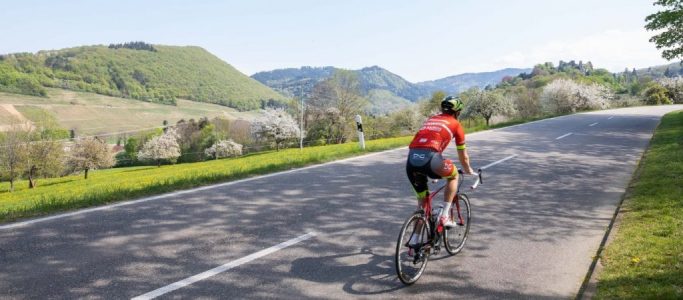We’re all used to going out on rides by ourselves, on roads we are familiar with. Most of us are also used to riding on unfamiliar roads in fully supported events. But riding on unfamiliar roads, without active support requires a bit more preparation, especially in light of the COVID-19 pandemic. Here are some tips to help you have safe and enjoyable rides.
Navigation
Whether you are planning a route of your own or are utilizing one provided to you, take a fault tolerant approach, so you are as prepared as possible:
- Review the course ahead of time; while you won’t recall everything, at least you’ll have seen things beforehand.
- Use a GPS device and turn-by-turn directions. This can be a GPS cycling computer or an App on your smart phone.
- Bring a Cue Sheet (either a paper copy or stored as a PDF saved on your smart phone)
- Old School Tip: Carry your cue sheets in a plastic bag to protect it from sweat or rain
- Ideally you do all of these; a belt & suspenders approach rarely lets you down. Having a smart phone with maps saved will allow you to re-route should you experience road closures or need to take a short cut.
Hydration & Nutrition
Having enough food and drink on hand during a long ride can be a challenge, but is not impossible, with a little preparation. Hopefully you’ll have noted where stores are on the course, but you should start with plentiful supplies, just in case.
- Start with 2 Full Bottles, filled at home
- Start with a number of bars, gels, chews, or your favorite real food in your jersey pockets or bike bags
- Carry your favorite drink mix in plastic baggies, pre-measured to fill your particular bottles. Alternatively, some brands offer single serving pouches or electrolyte tablets
- Old school tip; before electrolyte tablets were available, riders often carried antacids, like Rolaids or Tums for a quick chewable source of calcium and magnesium
- Carry extra fluids with you; use a hydration pack or carry an extra bottle in your jersey pockets (our favorite is the BackBottle)
- Learn where stores, water fountains and restrooms are on your route
- Don’t skip a store or pass by an opportunity to top up your bottles without knowing when the next opportunity might be.
- Extreme Tip: Carrying a 4-Way Sillcock Key (water spigot wrench) can give you access to hose bibs that don’t have spigots in an emergency
- Pack a cooler with food and drink for post ride consumption, even if it is just a little something before you drive to a location for something more substantial
Health, Hygiene and Sanitation
- Bring a mask; even if you chose not to wear it while riding, during the COVID-19 pandemic, you’ll need it to enter most stores and often when crossing state lines.
- If you carry it in your pockets, place it in a plastic bag to keep it dry.
- Carry a small bottle of hand sanitizer in your jersey or bike bag, so you can periodically clean your hands when hand washing isn’t possible
- Consider carrying a few sanitizing wipes, in case you need to wipe something down
- Consider carrying a small tube of sunscreen, so you can reapply when needed.
- Consider carrying a small wad of toilet paper in a plastic bag; with many public restrooms closed, you never know when you’ll need to improvise.
- Pack Wet Wipes/Baby Wipes and a towel to clean up post ride
- Old School Tip: bring a bottle of pre-mixed Soapy Water to wash with
- Pack in Pack Out; don’t recklessly discard your trash, stash it in your pockets or bags until you can find a proper trash can
Communication
- Inform your loved ones of your plans, so they have a general idea of where you will be
- Consider using a GPS or phone tracking app
- Electronics, particularly smart phones can deplete batteries quickly, when lots of apps are active, the screen is on, and antennas (Bluetooth, GPS and phone) are in use. Turn off unnecessary features and applications
- Consider carrying a small power bank and appropriate cables, so you can charge things while you are stopped
- Pro Tip: you can zip tie a small power bank to your bike (stems are a great place) and cover the connectors with painter’s tape to keep dust out.
Bicycle Maintenance
- Make sure your bike is in good working order before your ride
- Learn how to perform basic repairs
- Avoid making changes to your equipment right before your ride; always test things out first
Equipment
Ignore the rules! If you are a fan of the Velominati, you’ll find some of these tips are in violation of “The Rules”, particularly Rules 29 – 32 & 91. These rules are part tongue in check, so don’t treat them too seriously. To be self-sufficient on a day long ride, you’ll most likely appreciate a saddle bag, and possibly a frame or handlebar bag to supplement your jersey pockets
- Consider using blinky lights, particularly rear ones, to improve your visibility to motorists
- Bring Plenty of Spares
- Tubes
- CO2 Cartridges
- Consider carrying a frame or mini pump, even if you have CO2
- Patch Kit
- Something to make a tire boot from
- Carry appropriate tools for your bike
- Dress Appropriately, be prepared for the forecasted conditions

Recent Comments